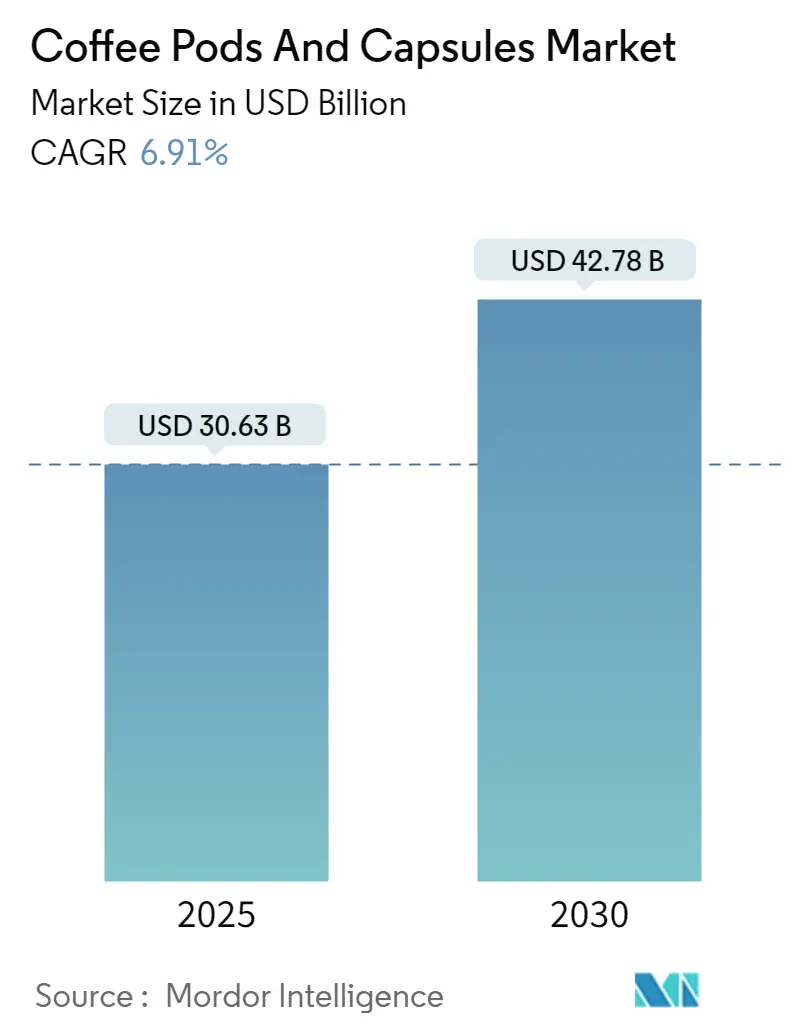
| Study Period | 2019 - 2030 |
| Market Size (2025) | USD 30.63 Billion |
| Market Size (2030) | USD 42.78 Billion |
| CAGR (2025 - 2030) | 6.91 % |
| Fastest Growing Market | Asia-Pacific |
| Largest Market | Europe |
| Market Concentration | High |
Major Players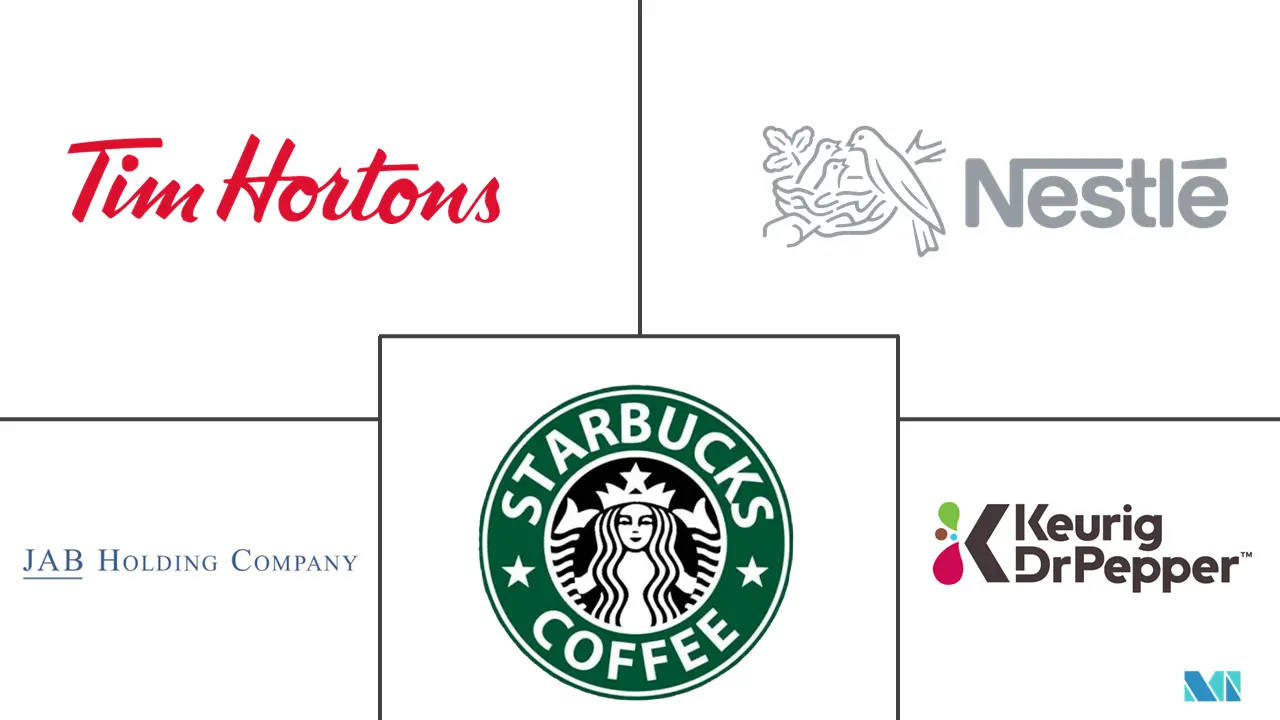
*Disclaimer: Major Players sorted in no particular order |
Coffee Pods and Capsules Market Analysis
The Coffee Pods And Capsules Market size is estimated at USD 30.63 billion in 2025, and is expected to reach USD 42.78 billion by 2030, at a CAGR of 6.91% during the forecast period (2025-2030).
The coffee pods and capsules industry is undergoing a significant transformation driven by increasing environmental consciousness and sustainability initiatives. Major manufacturers are actively developing eco-friendly alternatives to address environmental concerns associated with traditional plastic and aluminum capsules. A notable development in this direction was Nespresso's launch of compostable coffee pods in November 2022, marking a significant shift in the industry's approach to sustainable packaging. Companies across the sector are investing in research and development to create biodegradable coffee capsules that maintain product quality while reducing environmental impact, with several players introducing recyclable coffee pods to their product portfolios.
The market is experiencing a notable shift toward premiumization and specialty coffee capsules offerings, reflecting evolving consumer preferences for high-quality, artisanal coffee experiences at home. Premium coffee pods and capsules manufacturers are differentiating themselves through superior bean quality, unique roasting techniques, and exclusive flavor profiles. This trend is particularly evident in the rising popularity of single-origin coffee pods and specialty blends, which offer consumers cafe-quality experiences in the convenience of their homes. The industry has witnessed an increase in partnerships between premium coffee brands and pod manufacturers to create exclusive product lines catering to sophisticated coffee enthusiasts.
The distribution landscape for coffee pods and capsules continues to evolve, with a significant emphasis on omnichannel presence and direct-to-consumer models. Supermarkets and hypermarkets remain dominant distribution channels, accounting for over 44% of off-trade sales, while online retail channels are experiencing rapid growth. Companies are increasingly focusing on developing strong e-commerce capabilities and subscription-based models to enhance customer convenience and build lasting relationships. The retail strategy has shifted toward creating immersive brand experiences through dedicated brand stores and shop-in-shop concepts.
Technological innovation is driving significant changes in product development and consumer interaction within the market. Manufacturers are incorporating smart technology into coffee brewing systems and developing compatible pods that offer customizable brewing experiences. The industry is witnessing increased investment in sustainable production technologies and smart packaging solutions that enhance product freshness and user experience. Companies are also leveraging digital platforms to educate consumers about product features, sustainability initiatives, and proper disposal methods, creating a more informed and engaged customer base.
Coffee Pods and Capsules Market Trends
INCREASING USAGE OF SINGLE-SERVE COFFEE IS DRIVING THE COFFEE PODS AND CAPSULE DEMAND
The quality, efficiency, and diverse choices offered in single-serving coffee formats have become major catalysts driving the coffee capsules and pods market forward. Consumers are increasingly investing in coffee machine pods to recreate premium café-style experiences at home, which has directly contributed to the surge in demand for coffee capsules and pods. The convenience factor has become particularly appealing to working professionals and urban consumers who seek quality coffee without investing significant time in preparation. This shift in consumer preference is evident in the rapid expansion of coffee chains and specialty coffee outlets, with companies like Starbucks expanding their presence to 1,156 stores in the United Kingdom alone by 2022, including 838 franchised and 318 company-operated locations.
The market has witnessed a significant transformation as active players respond to the growing single-serve coffee demand by launching innovative products such as lattes and cappuccinos to penetrate this highly potential segment. Major brands including Keurig Green Mountain, Starbucks, and Kraft Heinz Co. have expanded their presence across supermarkets, drugstores, and select dollar chains nationwide. The proliferation of premium coffee shops has further stimulated consumers' appetite for high-end, fresh-brewed coffee, leading to increased adoption of coffee capsules. Premium brands like Nespresso and Nescafe Dolce Gusto play significant roles in the capsule market, while other single-serve brands such as Keurig, Jacobs Douwe Egberts, Tassimo, and Senseo continue to innovate and enhance the value proposition for consumers.
INCREASING POPULARITY OF SPECIALTY AND ORGANIC COFFEE PODS AND CAPSULES
The rising consumer preference for specialty and organic coffee pods and capsules has emerged as a significant market driver, reflecting broader shifts in consumer consciousness toward premium and sustainably sourced products. This trend is particularly evident in European markets, where organic coffee sales have shown remarkable growth. In Denmark, the annual turnover of organic coffee in retail shops reached 335 million Danish kroner in 2022, while in Germany, approximately 74% of all fair trade coffee sold in 2021 came from organic production, marking a significant increase from 68% in the previous year. These statistics underscore the growing consumer demand for high-quality, certified organic coffee products in convenient pod and capsule formats.
The market has responded to this trend with innovative product launches and sustainability initiatives. In July 2023, Darlington-based manufacturer Beanies introduced compostable coffee pods in Aldi stores across the United Kingdom, offering flavors like vanilla, caramel, and hazelnut. Similarly, Cafe Royal made a significant breakthrough in September 2022 with their spherical-shaped pod featuring a vegetable-based, 100% compostable shell, representing a zero-waste solution for capsules. These innovations demonstrate how manufacturers are successfully combining premium quality with environmental responsibility, addressing both the growing demand for specialty coffee and sustainability concerns. The trend is further supported by companies like Chamberlain Coffee, which launched their first-ever commercially compostable coffee pods in December 2022, emphasizing organic sourcing and sustainable packaging solutions.
Segment Analysis: By Type
Capsules Segment in Coffee Pods and Capsules Market
The capsules segment continues to dominate the global coffee capsules and pods market, holding approximately 58% of the market share in 2024. This significant market position can be attributed to the segment's ability to offer convenience and compatibility with a wide variety of coffee machines. Coffee capsules have gained high acceptance among consumers due to their suitability, ease of use, and the diverse range of coffee products available. The proliferation of premium coffee shops has stimulated consumers' appetite for high-end, fresh-brewed coffee, which has increased the demand for coffee capsules. Major manufacturers like Nespresso and Nescafe Dolce Gusto have played a significant role in driving the capsule market's growth through continuous innovation in flavors, sustainable packaging solutions, and enhanced user experience.
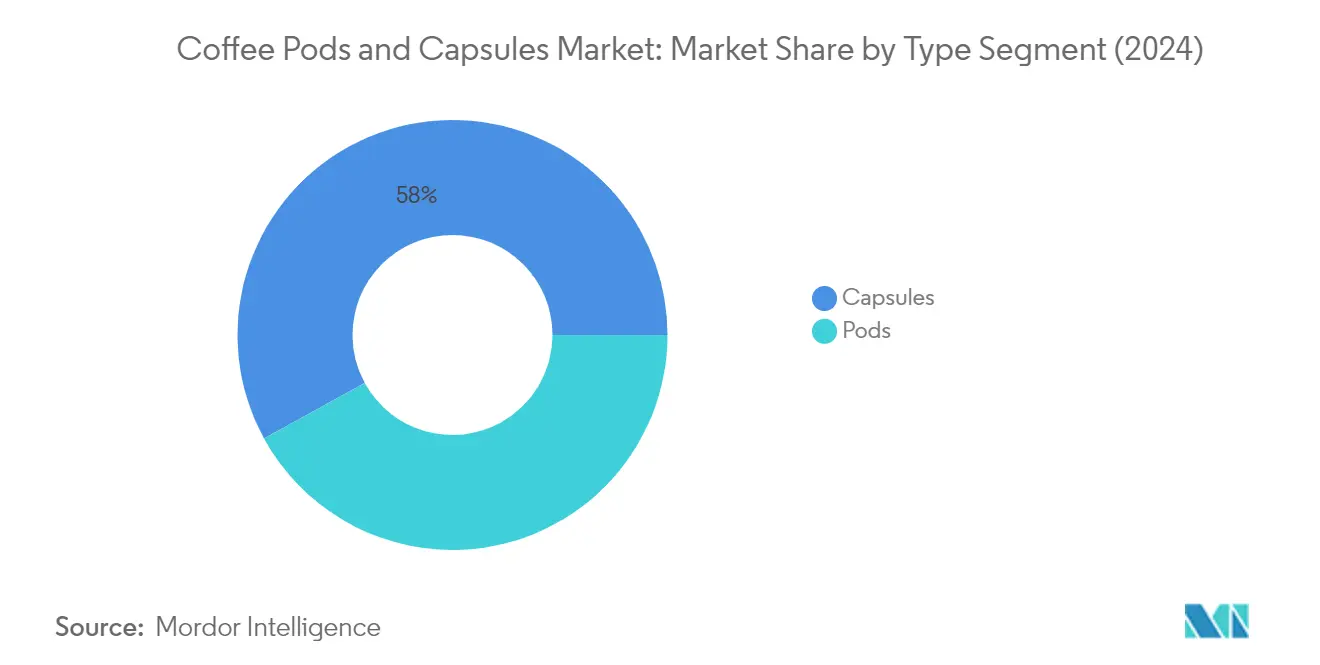
Pods Segment in Coffee Pods and Capsules Market
The pods segment is emerging as the fastest-growing segment in the coffee pods & capsules market, projected to grow at approximately 7% CAGR from 2024 to 2029. This growth is primarily driven by the increasing consumer preference for single-serve coffee options that offer convenience without compromising on quality. Coffee pods are gaining popularity due to their portability, precise portion control, and compatibility with various coffee brewing systems. The segment's growth is further supported by the introduction of eco-friendly and biodegradable pods by manufacturers, addressing environmental concerns while maintaining product quality. Additionally, the expansion of premium and gourmet coffee pod offerings is attracting mid-market and high-end buyers who continue to adopt single-serve coffee solutions.
Segment Analysis: Distribution Channel
Off-trade Segment in Coffee Pods and Capsules Market
The off-trade segment continues to dominate the global coffee pods and capsules market, commanding approximately 91% market share in 2024. This substantial market presence is primarily driven by the convenience and accessibility offered through various retail channels, including supermarkets, hypermarkets, specialist stores, and online platforms. Supermarkets and hypermarkets lead the off-trade segment, accounting for nearly 44% of total market revenue, owing to their strategic locations near residential areas and the ability to showcase a wide variety of coffee pod and capsule brands under one roof. The segment's dominance is further strengthened by the increasing consumer preference for at-home coffee consumption and the growing availability of premium and specialty coffee capsules across retail outlets.
Online Retailing Segment in Coffee Pods and Capsules Market
The online retailing segment within the off-trade distribution channel is experiencing remarkable growth, projected to expand at approximately 10% CAGR from 2024 to 2029. This accelerated growth is driven by the increasing adoption of e-commerce platforms, particularly among millennials who prefer the convenience of doorstep delivery and subscription-based coffee pod services. Online retailers are enhancing their market position by offering exclusive product ranges, competitive pricing, and customer loyalty programs. The segment's growth is further propelled by the rising penetration of smartphones, improving internet connectivity, and the expansion of direct-to-consumer business models by major coffee brands. Many manufacturers are prioritizing online channels by launching new products exclusively through e-commerce platforms and developing innovative digital marketing strategies to capture a larger consumer base.
Remaining Segments in Distribution Channel
The on-trade segment, which includes cafes, restaurants, and other foodservice establishments, plays a crucial role in introducing consumers to premium coffee experiences and new pod varieties. Specialist stores contribute significantly by offering expert guidance, personalized shopping experiences, and exclusive premium products that are often not available in mainstream retail channels. These stores particularly cater to coffee connoisseurs and quality-conscious consumers seeking specialized coffee pod varieties. The other distribution channels, including convenience stores and mass merchandisers, serve as important touchpoints for impulse purchases and emergency buying situations, helping to maintain the market's overall accessibility and convenience factor for consumers.
Coffee Pods And Capsules Market Geography Segment Analysis
Coffee Pods and Capsules Market in North America
North America represents one of the most mature markets for coffee pods and capsules, driven by high coffee consumption and widespread adoption of single-serve brewing systems. The region's market is characterized by a strong presence of major players like Keurig Dr Pepper, Starbucks, and Nespresso. The United States dominates the regional landscape, followed by Canada and Mexico, with consumers increasingly preferring premium and specialty coffee varieties. The market is witnessing a shift toward sustainable and environmentally friendly coffee pods and capsules, with manufacturers focusing on developing recyclable and biodegradable options to address environmental concerns.
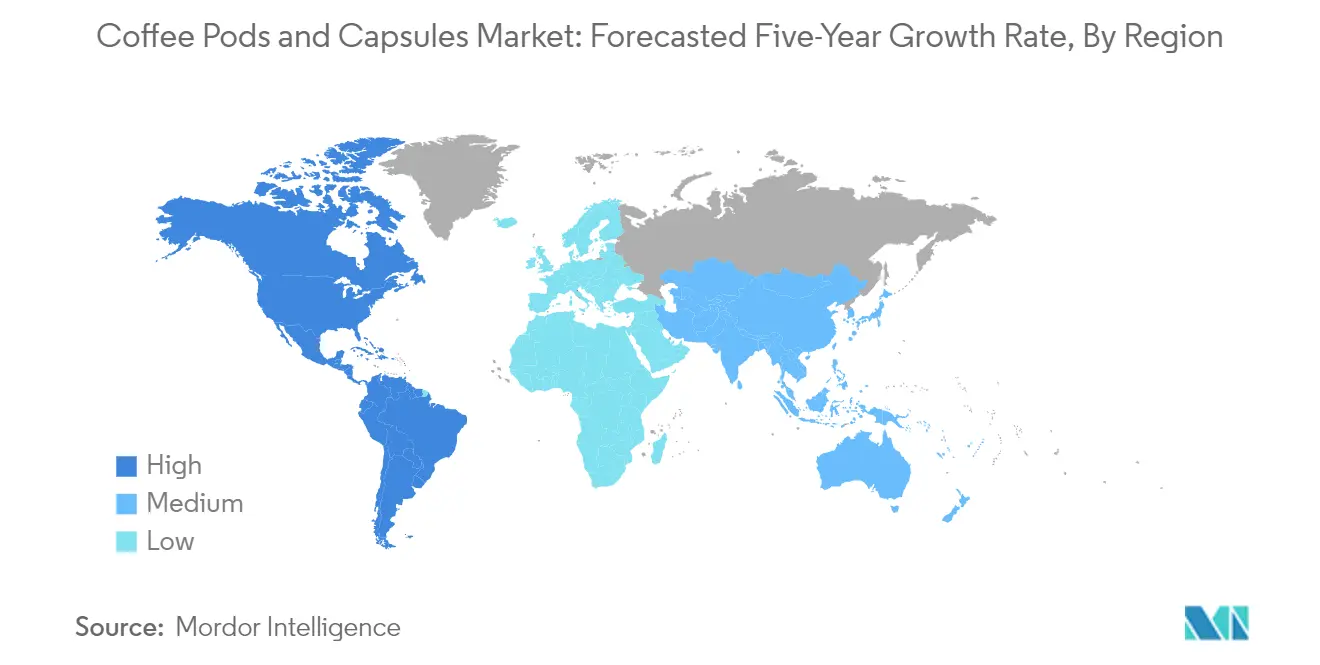
Coffee Pods and Capsules Market in United States
The United States leads the North American market with approximately 89% market share in the region. The country's dominance is attributed to the high penetration of single-serve coffee machines in households and offices. According to industry data, about 40% of US consumers own a single-cup coffee capsule system, highlighting the strong consumer base. The market is driven by the convenience factor coupled with increasing demand for premium coffee experiences at home. Major retail chains and coffee shops are expanding their pod offerings, while manufacturers are introducing innovative flavors and organic options to cater to evolving consumer preferences.
Coffee Pods and Capsules Market in Mexico
Mexico emerges as the fastest-growing market in North America, with a projected growth rate of approximately 7% during 2024-2029. The growth is primarily driven by the rising adoption of Western coffee culture and increasing disposable income among urban consumers. Mexican consumers are showing growing interest in the premium experience of single-serve coffee, especially in away-from-home channels. The market is witnessing increased competition with both international and local players introducing innovative products aligned with local taste preferences. The middle-class consumers in the country are particularly drawn to coffee portion packs as they offer a cost-effective alternative to café-style coffee while maintaining quality.
Coffee Pods and Capsules Market in Europe
Europe stands as the largest market for coffee pods and capsules globally, with a robust coffee culture and high consumer acceptance of premium coffee products. The region benefits from the presence of established coffee brands and innovative product launches. Countries like France, Germany, Italy, and the United Kingdom are key contributors to the market growth, each with distinct consumption patterns and preferences. The market is characterized by strong competition among major players and an increasing focus on sustainable packaging solutions to address environmental concerns.
Coffee Pods and Capsules Market in France
France dominates the European market with approximately 27% market share in the region. The country's leadership position is supported by high coffee consumption rates and a strong presence of premium coffee brands. Over 70% of French households own at least one coffee capsule system, demonstrating the deep market penetration. The market is characterized by sophisticated consumer preferences, with growing demand for sustainable and certified coffee products. French consumers have traditionally shown a strong preference for Robusta beans, though consumption patterns are gradually evolving to accommodate milder coffee varieties.
Coffee Pods and Capsules Market in United Kingdom
The United Kingdom represents the fastest-growing market in Europe, with an expected growth rate of approximately 8% during 2024-2029. The growth is driven by an increasing coffee culture and rising preference for premium coffee experiences at home. Millennials are the biggest drivers of increasing sales of coffee brewing capsules, attracted by the convenience factor and wide range of flavors available. The market is witnessing significant innovation in sustainable packaging solutions, with manufacturers introducing compostable and recyclable options to meet growing environmental consciousness among consumers.
Coffee Pods and Capsules Market in Asia-Pacific
The Asia-Pacific region represents an emerging market for coffee pods and capsules, with significant growth potential driven by changing consumer preferences and increasing westernization of coffee consumption habits. The region encompasses diverse markets including Australia, Japan, and China, each with unique consumption patterns and growth drivers. The market is witnessing increased investment from global players, with a focus on product innovation and distribution network expansion to capture the growing demand.
Coffee Pods and Capsules Market in Australia
Australia leads the Asia-Pacific market, demonstrating strong consumer acceptance of premium coffee products and a sophisticated coffee culture. The country's market is driven by the growing influence of café culture in Australian homes and rising preference for high-quality coffee products. Consumers are increasingly looking to replicate the café experience in their homes with fresh coffee beans and fresh-ground aluminum coffee capsules. The market is characterized by continuous innovation in terms of flavor, variety, and price points to increase the consumer base.
Coffee Pods and Capsules Market in China
China emerges as the fastest-growing market in the Asia-Pacific region, showing strong potential for future expansion. The growth is primarily driven by the country's shifting preferences in coffee choices, especially among millennials. The market is witnessing increased investment from global players, with major coffee chains expanding their presence and introducing new product variants. Chinese consumers are showing growing interest in premium coffee experiences, leading to increased adoption of plastic coffee capsules for home consumption.
Coffee Pods and Capsules Market in Rest of the World
The Rest of the World region, comprising South America and the Middle East & Africa, presents diverse growth opportunities in the coffee pods and capsules market. South America emerges as both the largest and fastest-growing market in this region, benefiting from its strong coffee production heritage and evolving consumer preferences. The Middle East & Africa region is witnessing increased penetration of international coffee chains and growing acceptance of Western coffee culture. The market is characterized by rising investment in coffee pod manufacturing facilities and increasing focus on product innovation to meet local taste preferences. Both regions are seeing growing adoption of coffee pods among urban consumers, particularly young professionals seeking convenient yet premium coffee experiences.
Coffee Pods and Capsules Industry Overview
Top Companies in Coffee Pods and Capsules Market
The global coffee pods and capsules industry is characterized by intense innovation and strategic developments among key players like Nestlé, JDE Peet's, and Luigi Lavazza. Companies are focusing on launching premium products, sustainable packaging solutions, and expanding their distribution networks to maintain market positions. Product development efforts are centered around biodegradable pods, enhanced flavor profiles, and compatibility with various coffee brewing systems. Operational excellence is being achieved through investments in high-speed production lines, automated manufacturing processes, and strengthened supply chain networks. Strategic partnerships, particularly in emerging markets, demonstrate the industry's commitment to geographical expansion and market penetration. Companies are also emphasizing direct-to-consumer channels and digital transformation initiatives to enhance customer engagement and service delivery.
Consolidated Market Led By Global Players
The coffee pods and capsules market exhibits a highly consolidated structure dominated by multinational corporations with established brand portfolios and extensive distribution networks. These major players leverage their research capabilities, manufacturing expertise, and marketing prowess to maintain their market positions while continuously expanding their product offerings. The landscape is characterized by significant barriers to entry, including high capital requirements, technological expertise, and the need for economies of scale in production. Regional players maintain their presence through specialized offerings and strong local distribution networks, though their market share remains limited compared to global leaders.
The market has witnessed substantial merger and acquisition activity, reflecting companies' strategies to strengthen their market presence and expand their geographical footprint. Strategic acquisitions focus on gaining access to new markets, acquiring innovative technologies, and expanding production capabilities. Joint ventures and partnerships, particularly in emerging markets, have become common approaches for market entry and expansion. Companies are also investing in vertical integration to ensure better control over the supply chain and maintain product quality standards.
Innovation and Sustainability Drive Future Success
Success in the coffee pods and capsules market increasingly depends on companies' ability to address environmental concerns while maintaining product quality and convenience. Incumbent players must focus on sustainable packaging solutions, recyclable materials, and environmentally friendly production processes to maintain their market leadership. Investment in research and development for innovative pod designs, enhanced flavor profiles, and improved brewing technologies remains crucial. Companies need to strengthen their direct-to-consumer channels and digital presence while maintaining strong relationships with traditional retail partners.
Market contenders can gain ground by focusing on niche segments, developing unique value propositions, and leveraging regional strengths. The rising consumer preference for premium and specialty coffee creates opportunities for new entrants with distinctive offerings. However, companies must navigate challenges including high buyer concentration in retail channels, intense competition from traditional coffee formats, and growing environmental regulations. Success requires building strong brand identity, establishing efficient distribution networks, and maintaining flexibility to adapt to changing consumer preferences and regulatory requirements. Additionally, the emergence of private label coffee pods offers a unique avenue for differentiation and market penetration.
Coffee Pods and Capsules Market Leaders
-
Keurig Dr Pepper Inc.
-
Starbucks Corporation
-
Nestlé SA
-
Tim Hortons
-
JAB Holding Companies
- *Disclaimer: Major Players sorted in no particular order
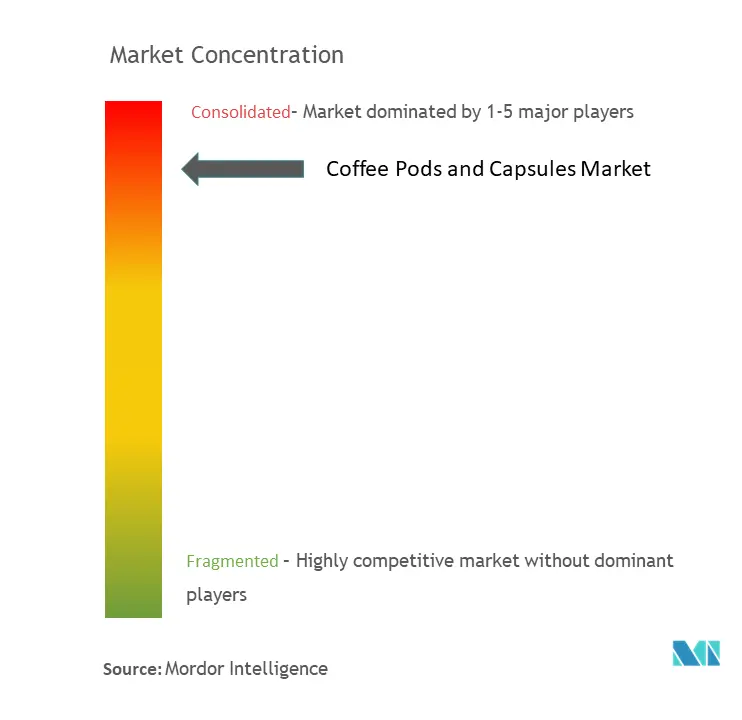
Coffee Pods and Capsules Market News
- September 2022: Swiss coffee brand "CoffeeB" introduced a groundbreaking single-serve coffee innovation—a compressed coffee ball encased in seaweed-based material, diverging from traditional aluminum or plastic capsules.
- August 2022: Tim Hortons expanded its offerings with four new espresso capsule varieties compatible with Nespresso machines, featuring classic, bright, bold, and decaf options.
- October 2021: Starbucks by Nespresso expanded its product line with Nespresso Vertuo coffee capsules, enriching the Canadian coffee experience with more ways to savor the signature café taste.
Coffee Pods And Capsules Market Report - Table of Contents
1. INTRODUCTION
- 1.1 Study Assumptions and Market Definition
- 1.2 Scope of the Study
2. RESEARCH METHODOLOGY
3. EXECUTIVE SUMMARY
4. MARKET DYNAMICS
-
4.1 Market Drivers
- 4.1.1 Demand for specialty and organic coffee pods and capsules
- 4.1.2 Innovations in packaging formats
-
4.2 Market Restraints
- 4.2.1 Availability of counterfeit products
-
4.3 Industry Attractiveness - Porter's Five Forces Analysis
- 4.3.1 Threat of New Entrants
- 4.3.2 Bargaining Power of Buyers/Consumers
- 4.3.3 Bargaining Power of Suppliers
- 4.3.4 Threat of Substitute Products
- 4.3.5 Intensity of Competitive Rivalry
5. MARKET SEGMENTATION
-
5.1 Type
- 5.1.1 Pods
- 5.1.2 Capsules
-
5.2 Distribution Channel
- 5.2.1 Supermarkets/Hypermarkets
- 5.2.2 Specialty Stores
- 5.2.3 Online Retailing
- 5.2.4 Other Distribution Channels
-
5.3 Geography
- 5.3.1 North America
- 5.3.1.1 United States
- 5.3.1.2 Canada
- 5.3.1.3 Mexico
- 5.3.1.4 Rest of North America
- 5.3.2 Europe
- 5.3.2.1 Germany
- 5.3.2.2 United Kingdom
- 5.3.2.3 Italy
- 5.3.2.4 France
- 5.3.2.5 Russia
- 5.3.2.6 Spain
- 5.3.2.7 Rest of Europe
- 5.3.3 Asia-Pacific
- 5.3.3.1 China
- 5.3.3.2 Japan
- 5.3.3.3 India
- 5.3.3.4 Australia
- 5.3.3.5 Rest of Asia-Pacific
- 5.3.4 South America
- 5.3.4.1 Brazil
- 5.3.4.2 Argentina
- 5.3.4.3 Rest of South America
- 5.3.5 Middle-East and Africa
- 5.3.5.1 United Arab Emirates
- 5.3.5.2 South Africa
- 5.3.5.3 Rest of Middle-East and Africa
6. COMPETITIVE LANDSCAPE
- 6.1 Market Share Analysis
- 6.2 Most Active Companies
-
6.3 Company Profiles
- 6.3.1 Nestle SA
- 6.3.2 JAB Holding Company
- 6.3.3 The Kraft Heinz Company
- 6.3.4 Inspire Brands Inc. (Dunkin' Brands)
- 6.3.5 Luigi Lavazza SpA
- 6.3.6 Starbucks Corporation
- 6.3.7 Gloria Jean's Coffees
- 6.3.8 Strauss Group
- 6.3.9 Coffeeza
- 6.3.10 Trilliant Food & Nutrition LLC
- *List Not Exhaustive
7. MARKET OPPORTUNITIES AND FUTURE TRENDS
Coffee Pods and Capsules Industry Segmentation
A single-serve coffee container is a method for coffee brewing that prepares only enough coffee for a single portion.
The coffee pods and capsules market is segmented by type, distribution channel, and geography. The market is segmented by type into pods and capsules. By distribution channel, the market is segmented into supermarkets/hypermarkets, specialty stores, online retailing, and other distribution channels, and by geography into North America, Europe, Asia-Pacific, South America, and Middle-East and Africa.
For each segment, the market sizing and forecast have been done on the basis of value (in USD).
| Type | Pods | ||
| Capsules | |||
| Distribution Channel | Supermarkets/Hypermarkets | ||
| Specialty Stores | |||
| Online Retailing | |||
| Other Distribution Channels | |||
| Geography | North America | United States | |
| Canada | |||
| Mexico | |||
| Rest of North America | |||
| Europe | Germany | ||
| United Kingdom | |||
| Italy | |||
| France | |||
| Russia | |||
| Spain | |||
| Rest of Europe | |||
| Asia-Pacific | China | ||
| Japan | |||
| India | |||
| Australia | |||
| Rest of Asia-Pacific | |||
| South America | Brazil | ||
| Argentina | |||
| Rest of South America | |||
| Middle-East and Africa | United Arab Emirates | ||
| South Africa | |||
| Rest of Middle-East and Africa | |||
Coffee Pods And Capsules Market Research Faqs
How big is the Coffee Pods And Capsules Market?
The Coffee Pods And Capsules Market size is expected to reach USD 30.63 billion in 2025 and grow at a CAGR of 6.91% to reach USD 42.78 billion by 2030.
What is the current Coffee Pods And Capsules Market size?
In 2025, the Coffee Pods And Capsules Market size is expected to reach USD 30.63 billion.
Who are the key players in Coffee Pods And Capsules Market?
Keurig Dr Pepper Inc., Starbucks Corporation, Nestlé SA, Tim Hortons and JAB Holding Companies are the major companies operating in the Coffee Pods And Capsules Market.
Which is the fastest growing region in Coffee Pods And Capsules Market?
Asia-Pacific is estimated to grow at the highest CAGR over the forecast period (2025-2030).
Which region has the biggest share in Coffee Pods And Capsules Market?
In 2025, the Europe accounts for the largest market share in Coffee Pods And Capsules Market.
What years does this Coffee Pods And Capsules Market cover, and what was the market size in 2024?
In 2024, the Coffee Pods And Capsules Market size was estimated at USD 28.51 billion. The report covers the Coffee Pods And Capsules Market historical market size for years: 2019, 2020, 2021, 2022, 2023 and 2024. The report also forecasts the Coffee Pods And Capsules Market size for years: 2025, 2026, 2027, 2028, 2029 and 2030.
Our Best Selling Reports
Coffee Pods And Capsules Market Research
Mordor Intelligence provides a comprehensive analysis of the coffee pods and capsules market. We leverage extensive expertise in coffee brewing systems and consumer trends. Our detailed research covers major segments, including tassimo pods, dolce gusto capsules, and nespresso compatible capsules. These insights are invaluable to understanding this dynamic industry. The report thoroughly examines specialty coffee capsules and private label coffee pods. It also analyzes various coffee pod packaging solutions and coffee portion packs that shape market dynamics.
Our analysis delves deeply into sustainability innovations. These include recyclable coffee pods, compostable coffee pods, and biodegradable coffee capsules, addressing growing environmental concerns. The report, available as an easy-to-read downloadable PDF, covers technical specifications of aluminum coffee capsules and plastic coffee capsules. It also explores emerging coffee capsule system technologies. Stakeholders gain crucial insights into coffee machine pods developments and reusable coffee pods trends. Additionally, evolving coffee brewing capsules technologies enable informed decision-making across the value chain.




